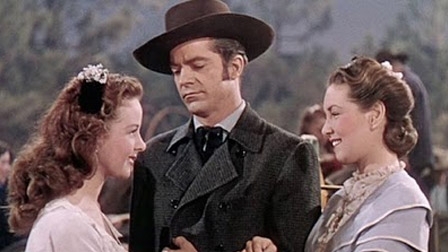
Between making bettered remembered films, Dana Andrews starred in an underappreciated 1946 frontier yarn made in glorious Technicolor by an extraordinarily unlikely director: Black and white film noir master Jacques Tourneur! The result is an entertaining, highly original (if blandly titled) Western: Canyon Passage.
The plot, set in mid-19th century Oregon, is not easy to summarize, which turns out to be one of the film’s virtues. Throughout there is a movie-length story thread concerning whether brave, restless entrepreneur Logan Stuart (Andrews) will marry a sweet, stay-at-home woman (Patricia Roc) or end up with the sassy, adventurous flame-haired beauty the audience knows is made for him (Susan Hayward) if only she were not engaged to his friend (Brian Donlevy). But there is much more to the film than that. It’s a slice of frontier life, told through different lenses. Indeed, the film’s highlight is an extended sequence of slight relevance to the love triangle storyline in which the pioneers raise a cabin for a newly married couple. The panoramic tale also includes subplots about the cruelty of “justice” in towns where no police or courts exist, the workings and risks of gold mining-based economic systems and how boredom leads small town dwellers to seek out destructive entertainments (e.g., egging on fistfights, engaging in compulsive gambling). Some critics found Canyon Passage too “plotty” but if you step back from the details and see it more as the story of a entire frontier community, it’s unified and not a bit overstuffed.
That style of storytelling is one sign that Tourneur clearly didn’t want to make a typical Western. Another is that the first closeup doesn’t occur until 15 minutes into the movie! Throughout the film, Tourneur keeps the camera at a distance from his stars (thereby driving producer Walter Wanger batty), which makes the audience think about the many characters in the town as a whole rather than just seeing them as background for the leads.
What makes Andrews’ commanding performance so enjoyable is the way he plays off three other talented actors. His flirty, forbidden jousting with Hayward has palpable electricity, his dedication to his flawed friend Donlevy is both inspiring and sad, and his conflict with a vicious local bully (Ward Bond) is gripping. Bond was a physical powerhouse, and his brutal character here is what Jud Fry would have been in Oklahoma! if he had regularly consumed steroids. The physical confrontation between Andrews and Bond, one of the film’s highlights, left both men bruised and in need of stitches (that’s an juicy detail in the engaging Carl Rollyson biography about Andrews that I recommended here). Other fine performances in the film are turned in by Andy Devine, Halliwell Hobbes and a then-unknown Lloyd Bridges. When such a large cast is uniformly good, you should credit the director, so hats off to Tourneur for his skill.
Whether you find this film to be outstanding or just pretty good may well turn on whether you are a fan of Hoagy Carmichael, who had an enormously successful and unique multi-decade career in Hollywood. He is primarily remembered for his music, but also acted in some movies in the 1940s and early 1950s including in the Andrews-anchored classic The Best Years of Our Lives (my favorite Carmichael role in is one of my recommendations, To Have and Have Not). Here he plays (what else?) a musically inclined shopkeeper and performs several original songs which he wrote for the movie, including Ole Buttermilk Sky and Silver Saddle. I think his music is pleasing in any event and also fits the movie particularly well, but see what you think.
One other note of praise before closing. This 1946 film was ahead of its time in humanizing Native Americans. Although they eventually go on a murderous spree, it’s clearly a response to the rape and murder of a young woman by a white man. There is also a revealing exchange in the cabin-raising sequence in which Andy Devine explains to the other settlers that the Indians do not object to sharing the frontier with them, but see the building as a statement of personal ownership of the land, which is alien to their culture. Unlike in the usual “good” cowboys versus “bad” Indians movies of the period, the horrifying conflict that eventually breaks out is appropriately portrayed as mutually tragic. That emotional dimension of the story’s climax is one of the many reasons Canyon Passage is a cut way above the typical Hollywood oater.
p.s. For another successful Tourneur-Andrews collaboration, please see my recommendation of Curse of the Demon.


